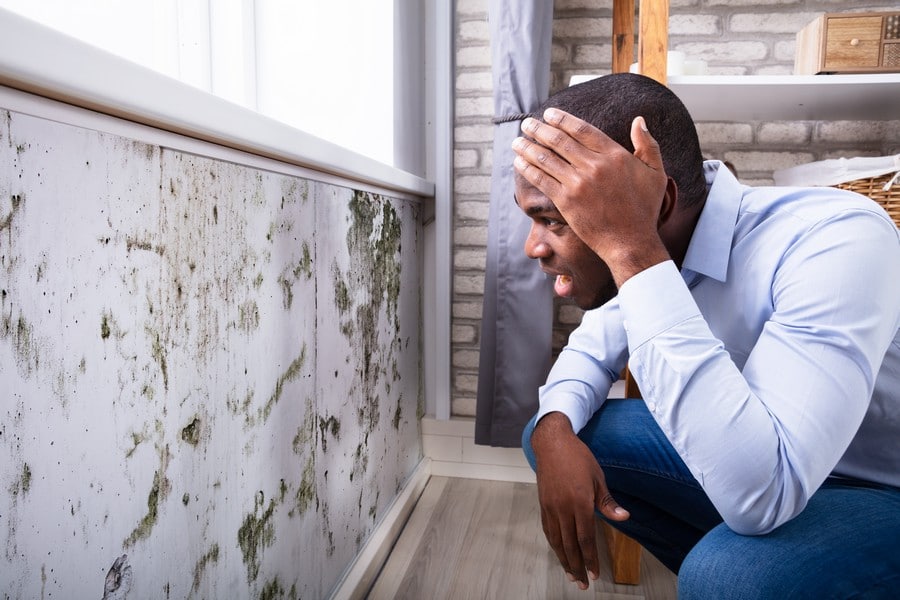What Is Damp?
A damp problem in a house indicates that water has found its way into the walls, floors, or ceilings. This can occur for various causes, including fractured pipes, excess condensation, loose or missing roof tile, or moisture rising from the earth, and some bricks becoming porous.
There are two forms of damp: one is mild, and the other is severe. The first form is ‘rising damp,’ which spreads vertically up walls from the ground, while the second is ‘penetrating damp,’ which spreads horizontally or downwards. Unfortunately, any form of damp will not disappear, and the problem will get worse and more expensive to fix over time.
In addition, excessive condensation can originate damp inside a building.
Damp homes can cause health issues, particularly in people who are allergic to mould spores and have skin, eye, and chest irritations. Dampness can aggravate medical disorders such as asthma.
As autumn arrives and winter approaches, it’s a good idea to assess your home for any damp issues or potential issues and address them as soon as possible.
What symptoms should you look for if you’ve decided to face the problem of moisture ‘head on’ or to check for problems?
Indicators Of Damp In A Property
Pay attention to the following critical rising damp signs:
Distinctive moist odour – The strongest of our five senses is our sense of smell. A moist room has a distinct damp, musty smell, which is amplified when the door is closed, or a wall cupboard is opened. Another symptom is an abnormally high level of moisture in the room. A musty odour may be the only symptom of a potential problem in the early stages.
Indicators on the walls or ceiling – Any moisture problems will show up on the walls in the form of mouldy mildew wet patches or a white coating that looks like a layer of sea salt crystals. An area of plaster may darken and change colour, or if the wall is papered, the paper may flake or peel. Another tell-tale symptom of wetness is a distinctive ‘tide mark’ that extends up to one metre above the floor. It’s fairly common for bricks to become permeable with age if you live in an older home. If there are any spots with black mould, there is most likely a mould problem. Examine the walls, floors, and ceilings for any tell-tale signs of wetness in a home. Look for moist places and peep beneath any flooring that appears to be buckling.
Different touch – Feeling different regions on your walls, floors, and ceilings carefully and systematically is a useful approach to check for any dampness, as damp surfaces feel strangely cool and humid. If you think your home is suffering from growing damp, try running your hands over the afflicted area. You should be able to feel the plaster salts if it feels damp. These are white deposits that have washed into the plaster from the bricks. If the area has wallpaper, move your fingers over the salts and listen for a slight crunching sound.
Inspect inside and outside walls – Damp problems can occur on either side of a wall, so it’s a good idea to check interior and external walls, windows, and roofs regularly and make any necessary repairs as soon as possible.
The easiest way to check for damp is to hire a professional surveyor. The surveyors will extensively inspect the property for any symptoms of moisture, both inside and out, and determine what type of damp it is and what the likely source is. The report will also give you tips on how to solve it.
For more info on damp surveys, please get in touch with Sussex Damp Experts.
What Are The Symptoms Of Rising Damp?
If you’re concerned that rising damp may be a problem, there are a few tell-tale indications to check for. These are some of them:
- Damp patches that start at the bottom of a wall and work their way up;
- Decaying skirting boards or rotting plaster;
- You might notice floor coverings lifting such as tiles, vinyl, or carpets;
- Paint or wallpaper that is peeling due to an ineffective damp proof course;
- A white, powdery salt-like substance appears on a wall;
- On a wall, tidal traces or staining can be yellow or brown.
Sometimes rising damp can be difficult to cope with, and it can be costly to address.
If you feel there is a problem, contact a professional as soon as possible.
Sussex Damp Experts have a complete team of specialists that can help you with all damp related issues at the property.
Signs Of Penetrating Damp
Penetrating damp is frequently caused by structural issues such as faulty guttering, damaged downpipes, damaged roofs, or wall fractures and can manifest in internal and exterior walls.
Old bricks can also become porous, allowing water to penetrate.
These are the most common signs of penetrating damp:
- Damaged wallpaper and plaster from the middle section upwards of the wall;
- Localised moist patches on the wall and ceiling at varying heights;
- Rain penetrates the property due to damage to the external wall, pebbledash or renders, and guttering.
Outside walls may develop darker patches or, in the case of rising moisture, dark swaths of tidal lines climbing up the walls, similar to inside walls.
You’ll probably see damp patches on brickwork and vegetation growing on external walls. You’ll observe localised external stains near the source of the moisture incursion if penetrating damp is the issue.
Symptoms Of Condensation
Condensation is the most prevalent type of moisture, and it can eventually lead to black mould growth. When the temperature dips below the temperature of moist air inside the property, it develops on inside surfaces. Keep an eye out for condensation since it may lead to an unattractive, musty property if left unattended. More significantly, it has the potential to aggravate or induce health issues such as asthma and other issues.
The following are the common signs of condensation in a property:
- Excess moisture on any cold surface, such as windows, tiles, or chilly walls;
- Humidity has increased;
- Mould growth on window frames or on the walls;
- A musty odour lingered;
- Windows and walls that stream;
- Walls, particularly behind furniture and in corners, can develop damp spots;
- The wallpaper may begin to peel;
- Window frames that have been blackened;
- Beginning of mould growth, generally black mould;
- Mould and mildew can grow on soft furniture and fabrics.
Where Should You Check For Damp?
It’s a good idea to start with the basement if your home – or a property you’re considering buying – has one. Also, If there is wet underneath the floors, they can decay, and the walls and ceilings can exhibit apparent evidence of damp. A tell-tale symptom is discolouration or moist areas on the walls, and you might also be able to smell it.
Because of the regular use of water in the bathroom, it is particularly prone to moisture. If yours has a lot of condensation, mould might proliferate. Keep an eye on the airing cupboard and the water heater in there as well.
We Are Here To Help You Deal With Damp
If you suspect wetness after completing these checks, seek professional treatment as soon as possible. A surveyor will come to your home and examine the extent of the problem. Sometimes a difficult-to-identify factor, such as faulty insulation, is to blame for the damp problem.
Depending on what is generating the damp, there are a variety of options for effective treatment. We at Sussex Damp Experts are experts at detecting and resolving damp issues, and we are always happy to assist you.
Suppose you find dampness in your home or mould invading your property. In that case, you should contact a professional right away to have them inspect and assess the damage to determine what remedies they can provide to remedy the situation. Make no do-it-yourself attempts to solve the problem that you will come to regret later.
We at Sussex Damp Experts will make sure that all of these issues are resolved. They’ll figure out what’s causing the wetness and make sure it’s fixed as soon as possible. All of our damp specialists have undergone extensive training to ensure that they always do the work to your satisfaction.
Dampness will never be an issue for you again, and mould will no longer be a friend in your home, thanks to our moisture proofing experts. Your family’s health will be protected. We will make sure that your property’s security is our priority. All you have to do is call or email us, and we’ll take care of the rest. All you have to do now is unwind and let go of your worries because we will provide you with exceptional service that will result in your complete pleasure.
Because wearing flippers isn’t an option, get plenty of reliable advice about which treatment will be the most successful and cost-effective for you.
Please get in touch with Sussex Damp Experts on 01273 257 765 or get in touch with us through email to receive the best professional advice on dealing with any damp issue.


